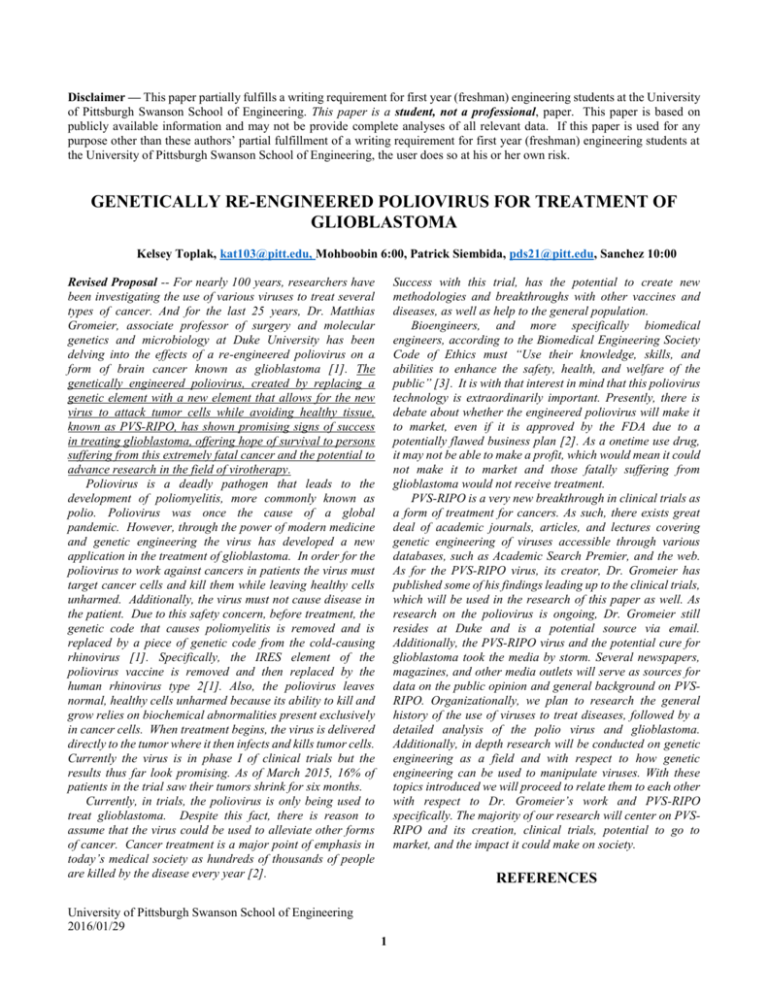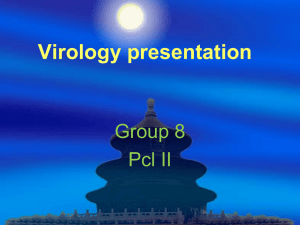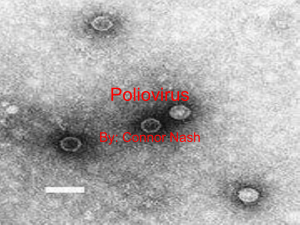genetically re-engineered poliovirus for treatment of glioblastoma
advertisement

Disclaimer — This paper partially fulfills a writing requirement for first year (freshman) engineering students at the University of Pittsburgh Swanson School of Engineering. This paper is a student, not a professional, paper. This paper is based on publicly available information and may not be provide complete analyses of all relevant data. If this paper is used for any purpose other than these authors’ partial fulfillment of a writing requirement for first year (freshman) engineering students at the University of Pittsburgh Swanson School of Engineering, the user does so at his or her own risk. GENETICALLY RE-ENGINEERED POLIOVIRUS FOR TREATMENT OF GLIOBLASTOMA Kelsey Toplak, kat103@pitt.edu, Mohboobin 6:00, Patrick Siembida, pds21@pitt.edu, Sanchez 10:00 Revised Proposal -- For nearly 100 years, researchers have been investigating the use of various viruses to treat several types of cancer. And for the last 25 years, Dr. Matthias Gromeier, associate professor of surgery and molecular genetics and microbiology at Duke University has been delving into the effects of a re-engineered poliovirus on a form of brain cancer known as glioblastoma [1]. The genetically engineered poliovirus, created by replacing a genetic element with a new element that allows for the new virus to attack tumor cells while avoiding healthy tissue, known as PVS-RIPO, has shown promising signs of success in treating glioblastoma, offering hope of survival to persons suffering from this extremely fatal cancer and the potential to advance research in the field of virotherapy. Poliovirus is a deadly pathogen that leads to the development of poliomyelitis, more commonly known as polio. Poliovirus was once the cause of a global pandemic. However, through the power of modern medicine and genetic engineering the virus has developed a new application in the treatment of glioblastoma. In order for the poliovirus to work against cancers in patients the virus must target cancer cells and kill them while leaving healthy cells unharmed. Additionally, the virus must not cause disease in the patient. Due to this safety concern, before treatment, the genetic code that causes poliomyelitis is removed and is replaced by a piece of genetic code from the cold-causing rhinovirus [1]. Specifically, the IRES element of the poliovirus vaccine is removed and then replaced by the human rhinovirus type 2[1]. Also, the poliovirus leaves normal, healthy cells unharmed because its ability to kill and grow relies on biochemical abnormalities present exclusively in cancer cells. When treatment begins, the virus is delivered directly to the tumor where it then infects and kills tumor cells. Currently the virus is in phase I of clinical trials but the results thus far look promising. As of March 2015, 16% of patients in the trial saw their tumors shrink for six months. Currently, in trials, the poliovirus is only being used to treat glioblastoma. Despite this fact, there is reason to assume that the virus could be used to alleviate other forms of cancer. Cancer treatment is a major point of emphasis in today’s medical society as hundreds of thousands of people are killed by the disease every year [2]. Success with this trial, has the potential to create new methodologies and breakthroughs with other vaccines and diseases, as well as help to the general population. Bioengineers, and more specifically biomedical engineers, according to the Biomedical Engineering Society Code of Ethics must “Use their knowledge, skills, and abilities to enhance the safety, health, and welfare of the public” [3]. It is with that interest in mind that this poliovirus technology is extraordinarily important. Presently, there is debate about whether the engineered poliovirus will make it to market, even if it is approved by the FDA due to a potentially flawed business plan [2]. As a onetime use drug, it may not be able to make a profit, which would mean it could not make it to market and those fatally suffering from glioblastoma would not receive treatment. PVS-RIPO is a very new breakthrough in clinical trials as a form of treatment for cancers. As such, there exists great deal of academic journals, articles, and lectures covering genetic engineering of viruses accessible through various databases, such as Academic Search Premier, and the web. As for the PVS-RIPO virus, its creator, Dr. Gromeier has published some of his findings leading up to the clinical trials, which will be used in the research of this paper as well. As research on the poliovirus is ongoing, Dr. Gromeier still resides at Duke and is a potential source via email. Additionally, the PVS-RIPO virus and the potential cure for glioblastoma took the media by storm. Several newspapers, magazines, and other media outlets will serve as sources for data on the public opinion and general background on PVSRIPO. Organizationally, we plan to research the general history of the use of viruses to treat diseases, followed by a detailed analysis of the polio virus and glioblastoma. Additionally, in depth research will be conducted on genetic engineering as a field and with respect to how genetic engineering can be used to manipulate viruses. With these topics introduced we will proceed to relate them to each other with respect to Dr. Gromeier’s work and PVS-RIPO specifically. The majority of our research will center on PVSRIPO and its creation, clinical trials, potential to go to market, and the impact it could make on society. REFERENCES University of Pittsburgh Swanson School of Engineering 2016/01/29 1 Kelsey Toplak Patrick Siembida [1]. M. Gromeier.“A Current Phase I Trial for Recurrent Glioblastoma Patients Opens for Accrual at the Preston Robert Tisch Brain Tumor Center.” Duke University Medical Center. (Online article) http://www.cancer.duke.edu/btc/modules/research3/index.ph p?id=41 [2]. A. Weintraub. (30 March, 2015). “Here’s What ‘60 Minutes’ Didn’t Tell You About the ‘Miracle’ Glioblastoma Treatment.” Forbes. (Online Article). http://www.forbes.com/sites/arleneweintraub/2015/03/30/her es-what-60-minutes-didnt-tell-you-about-the-miracleglioblastoma-treatment/#2715e4857a0b21a7bd29719 [3]. (February 2004) “Code of Ethics.” Biomedical Engineering Society. (Code of ethics). http://bmes.org/files/2004%20Approved%20%20Code%20o f%20Ethics(2).pdf will also provide us with certain statistics that will be useful in our paper. C. Goetz, M. Gromeier. (17 March 2010). “Preparing an oncolytic poliovirus recombinant for clinical application against glioblastoma multiforme.” Cytokine & Growth Factor Reviews. (Online Academic Journal). DOI: 10.1016/j.cytojfr.2010.02.005. pp.197-203. http://web.b.ebscohost.com/ehost/command/detail?sid=670b ac2c-3728-4aaf-bed078613d6cbe32%40sessionmgr111&vid=4&hid=124 In Cytokine and Growth Factor Reviews, Dr. Gromeier’s work on the PVS-RIPO virus can be found. His paper explains his current research on the virus in great detail as well as where his research will lead as the virus heads to clinical trials. As such, this source will be invaluable to understanding and conveying the current research being done on the polio virus and glioblastoma. ANNOTATED BIBLIOGRAPHY M. Gromeier.“A Current Phase I Trial for Recurrent Glioblastoma Patients Opens for Accrual at the Preston Robert Tisch Brain Tumor Center.” Duke University Medical Center. (Online article) http://www.cancer.duke.edu/btc/modules/research3/index.ph p?id=41 This online article, lists the details of the phase 1 clinical trial for recurrent glioblastoma patients. The article describes the background of the poliovirus being used to treat glioblastoma. Also, the article discusses how the virus works, the plans for the future, the clinical trials, and the greater significance of the virus. Information from this article will help us to provide a basic overview to introduce readers to the poliovirus. M. Boudin, A. Dennis. (2014, May 5). “Killing Cancer with Polio.” People. (Online article). pp. 174-178. http://web.b.ebscohost.com/ehost/detail/detail?sid=12f2e36a -2c90-4567-a5e45d7195796404%40sessionmgr198&vid=8&hid=105&bdata =JnNpdGU9ZWhvc3QtbGl2ZQ%3d%3d#anchor=AN00957 47947-4&AN=95747947&db=aph The periodical from People magazine gives a personalized description of one woman’s experience with glioblastoma and the poliovirus trial. The article describes in detail how the procedure was conducted as the poliovirus was injected directly into the tumor. The information from the periodical will help us to provide a detailed description of one’s personal experience with glioblastoma and an accurate description of the procedure. N. Nelson. (1999) “Viruses and Cancer.” Journal of the National Cancer Institute. DOI:10.1093/jnci/91.20.1709. (Academic Journal) This journal article comes from the Journal of the National Cancer Institute. It specifically discusses the history of the use of viruses in attempt to treat forms of cancer. The polio virus is mentioned specifically. Nelson points out that at the time the polio virus would eliminate part of the tumor, but the patient’s immuno response would override any affect of the virus in a short period of time. As such, this source will serve as a comparison between prior attempts of treating cancer with polio virus, and Dr. Gromeier’s PVS-RIPO strain. (February 2004) “Code of Ethics.” Biomedical Engineering Society. (Code of ethics). The Biomedical Engineering Society, often referred to as BMES, is a respected national professional society for those in the bioengineering field. As such, bioengineers must follow the code of ethics set forth by the BMES. The code of ethics will be used to understand and explain why poliovirus bioengineering researchers are working on this topic and the clinical trial process. “Glioblastoma (GBM).” American Brain Tumor Association. (Online Article). http://www.abta.org/brain-tumorinformation/types-oftumors/glioblastoma.html?referrer=https://www.google.com/ This online article, from the American Brain Tumor Association gives a detailed description of glioblastoma. It describes many aspects of the disease including symptoms, incidence, treatment and prognosis. This will provide us with helpful background that will allow us to accurately introduce the disease to our readers. The information from the article D. Sze, T. Reid, S. Rose. (August 2013). “Oncolytic Virotherapy.” Journal of Vascular and Interventional Radiology. DOI:10.1016/j.vir.2013.05.040. pp. 11151122.(Academic Journal). This source is found in the Journal of Vascular and Interventional Radiology on the topic on oncolytic viruses. This article details a history of oncolytic viruses as well as some of the research conducted with them in the past. This will prove useful in explaining the origins of the PVS-RIPO 2 Kelsey Toplak Patrick Siembida virus and the rationale behind using a virus as a form of cancer treatment. A. Weintraub. (30 March, 2015). “Here’s What ‘60 Minutes’ Didn’t Tell You About the ‘Miracle’ Glioblastoma Treatment.” Forbes. (Online Article). http://www.forbes.com/sites/arleneweintraub/2015/03/30/her es-what-60-minutes-didnt-tell-you-about-the-miracleglioblastoma-treatment/#2715e4857a0b21a7bd29719a The online article, from a popular press article details some of the possible shortcomings of the treatment. Additionally, the article describes how other viruses have been used to treat various forms of cancer. Information from the article will assist us in our description of the poliovirus by providing us with the problems that the virus needs to overcome and will supply us with helpful background info on cancer treating viruses. 3





